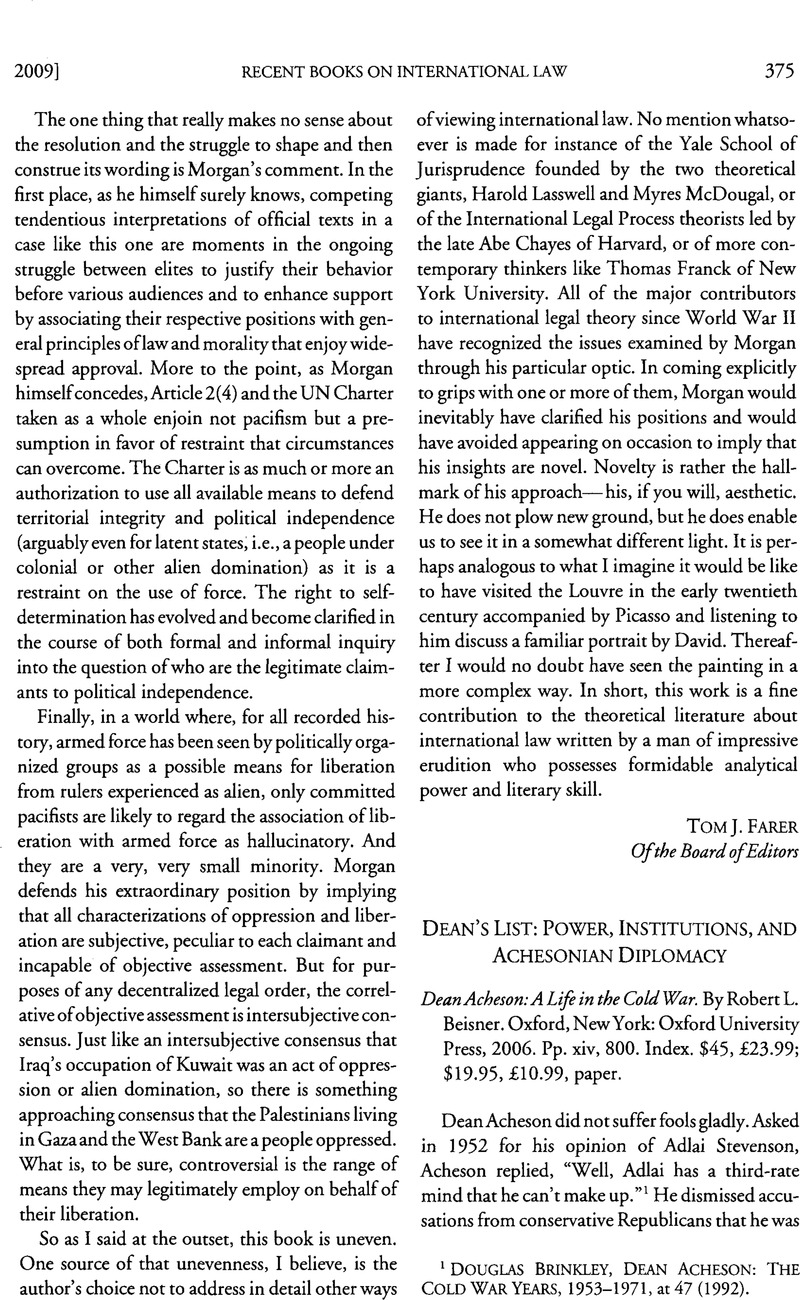Published online by Cambridge University Press: 27 February 2017

1 Douglas, Brinkley, Dean Acheson: The Cold War Years, 1953–1971, at 47 (1992)Google Scholar.
2 Dean, Acheson, Present at the Creation: My Years in the State Department 534 (1969)Google Scholar.
3 See Kai, Bird & Martin J., Sherwin, American Prometheus: The Triumph and Tragedy of J. Robert Oppenheimer (2005)Google Scholar
4 For example (p. 623): “Offered a glass of white wine before a late-afternoon lecture at the Brookings Institution, he demanded a dry martini. ‘The Brookings people,’ Arthur Schlesinger, Jr., records, ‘politely said that spirits were not available. ‘No martini,’ said Acheson, ‘no lecture.’ (He got the martini.)”
5 I have considered this period elsewhere. See Jonathan, Zasloff, Law and the Shaping of American Foreign Policy: The Twenty Years’ Crisis, 77 SO. Cal. L. Rev. 583–682 (2004)Google Scholar.
6 The phrase, of course, is from Robert D., Putnam, Diplomacy and Domestic Politics: The Logic of Two-Level Games, 42 Int’l Org. 427 (1988)Google Scholar.
7 Dean, Acheson, Lawyers in the Republic, in Fragments of My Fleece 127–28 (1971)Google Scholar (essay originally published in Esquire, July 1961).
8 See Lochner v. New York, 198 U.S. 45, 76 (Holmes, J., dissenting).
9 See, e.g., Robert J., Mcmahon, The Cold War on the Periphery: The United States, India, and Pakistan 144 (1994)Google Scholar (noting Acheson’s agreement in the general American consensus concerning Pakistan’s role in Middle East “defense”).
10 In fairness, as Robert McMahon makes clear, the lion’s share of the fault in the Truman administration’s south Asia policy belonged not to Acheson, but to Assistant Secretary of State George McGhee, whose wisdom on Iran was matched by his obtuseness on Pakistan.
11 In international relations theory parlance, “classical realism” refers to the tradition of realpolitik in statecraft and diplomacy. For good histories, see generally Michael Joseph, Smith, Realist Thought From Weber to Kissinger (1983)Google Scholar, and Jonathan, Haslam, No Virtue Like Necessity: Realist Thought in International Relations Since Machiavelli (2002)Google Scholar. “Neorealism,” or “structural realism,” refers to the theory that relies upon systemlevel factors to explain international outcomes, and sees relative power as the central determinant of those outcomes. Modern scholars disagree as to the relationship between these two intellectual trends (classical versus structural realism). See Neorealism and Its Critics (Robert O., Keohane ed., 1986)Google Scholar (especially chapters 4 and 5 by Kenneth Waltz).
12 See Bird & Sherwin, supra note 3.
13 The classic statement is found in Robert O., Keohane, The Demand for International Regimes, in International Institutions and State Power 101 (1989)Google Scholar. The notion is that by expanding negotiating opportunities, international institutions help transform transnational negotiations from a one-shot prisoner’s dilemma, in which each nation’s dominant strategy is to always defect, to an “iterated” one, in which a nation can punish defections by its partners, providing incentives for the partner to cooperate and thus to develop mutually beneficial outcomes.
14 See Marc, Trachtenberg, Reparation in World Politics: France and European Economic Diplomacy, 1916–1923, at 155–191 (1980)Google Scholar.
15 Beisner’s comment on this matter is well taken: “That [de Gaulle] used the alliance to challenge U.S. supremacy in Europe does not gainsay that peace and (p. 604).
16 One could read these developments as both constructivist and institutionalist. The institutional mechanisms of the European Union facilitated greater cooperation among member states but also changed their self-perceptions.
17 Richard H., Steinberg & Jonathan M., Zasloff, Power and International Law, 100 AJIL64, 86 (2006)Google Scholar.
18 A 1949 profile summed up Acheson’s appearance by reference to the secretary’s most outstanding physical feature:
In the morning light, his big reddish-gray mustache is an object of remarkable distinction. It has a personality of its own, and people who have happened by and seen Acheson emerge in the morning have often experienced the disquieting illusion that two entities are on their way to work, the Secretary and the Secretary’s mustache. ‘Honestly,’ a neighbor who goes to work at about the same time said recently, ‘some mornings the mustache appears to be a step or two ahead of the Secretary; other mornings it appears to be a step or two behind.’
Philip, Hamburger, Mr. Secretary—I, New Yorker, Nov. 12, 1949, at 41, 41 Google Scholar.
19 See Robert, Caro, 3 The Years of Lyndon Johnson: Master of the Senate 542–47 (2002)Google Scholar.
20 Henry A., Kissinger, A World Restored: Metternich, Castlereagh and the Problems of Peace 1812–1822, at 322 (1957)Google Scholar.